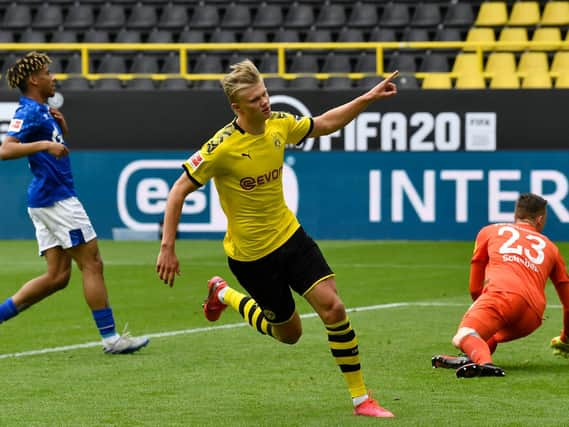Erling Haaland the android and a happy, historic reintroduction to football for Leeds United fans - Daniel Chapman


The old advice is to be careful what you wish for. Amid this pandemic, the Union of Genies might want to issue some new guidance: be careful what wishes you grant.
Hankering for football began the moment it went away, but when Borussia Dortmund and Schalke 04 appeared in a puff of smoke and disinfectant to make our dreams come true this weekend, the reaction from many was typically 2020: “Thanks, I hate it.”
Advertisement
Hide AdAdvertisement
Hide AdThe difference between wishes and reality was exposed by the forbidding silence of Dortmund’s empty Westfalenstadion. As the fussball genie’s new disclaimers will point out, though, it’s something we’ll have to get used to, because not much we’re given after the advent of Covid-19 is going to be the same as it was before.
The game is the same and Dortmund are still very good at it, although Schalke’s goalie was like a retrospective explanation for Felix Wiedwald’s pre-Leeds reputation. Erling Haaland started the scoring with typical emphasis, then celebrated by swaying at a safe social distance from his team-mates, like someone had made a robot version of his dad (former Leeds player, Alf-Inge) out of tin and pipe-cleaners but couldn’t get it to stand up straight.
Haaland the android seems so comfortable in his clockwork circuits that he was hardly missing the crowds. Asked why the Dortmund players saluted the empty stands at full-time, he whirred: “Why not?”
The rest of us felt the emptiness of our distance that crowds used to disguise. I live close enough to Headingley Stadium to open my window some evenings and hear the hum of a Rhinos crowd from beneath the floodlights on the horizon, with the occasional boom of Mousse T’s Horny ’98 as Ronnie The Rhino backflips along the try line. Not everyone in LS6 feels the same, but I love hearing that expectant crackle over the nightwaves. Maybe not the Horny part, but the rest. Football crowds have been an unchanging part of the game for so long that it is a shock to find them gone.
Advertisement
Hide AdAdvertisement
Hide AdIn ‘The Great Game’, a film from 1953, it takes five minutes of her first match for Thora Hird to start yelling “Clear offside!” above the cries of “Come on the Rovers!” around her. Put everyone in polyester and it could be today – well, last year. Perhaps it was time for a change.
Once we’re used to it, the new game offers new aesthetics.
Instead of the roar of the crowd, the slack ping-ripple of a ball hitting the net is a pleasure, a change as crunchy as Kraftwerk throwing their old guitars in the bin. There are new paths of understanding, too. On BT Sport, Steve McManaman started explaining the quality of Dortmund’s passing through its sound: “You can hear the ball fizzing around,” he said.
To get back in the game, Schalke needed: “A voice in the centre of midfield.” Should they sign Nina Hagen?
Borussia beat Schalke 4-0, a happy reintroduction for Leeds fans, watching our twin city beating former Huddersfield coach David Wagner. This month, Dortmund was supposed to be hosting an exhibition celebrating the relationship with Leeds, answering our version from last year but, like everything, it had to move online.
Advertisement
Hide AdAdvertisement
Hide AdThe regions have been related since 1949, although early dispatches from the King’s Own Yorkshire Light Infantry reported that “soul-destroying Dortmund ... does not differ much from Wigan”.
And was a fine place “if you like the outlook of a colliery”. Twinning happened in 1969, and the 50th anniversary festival programmes on Chapel FM’s website, and the bilingual stories and poems at leedsdortmund50.com, speak about communities and neighbours in ways that have changed since last year. Leeds author SJ Bradley’s story is about the old phrase ‘meeting yourself coming back’, and what we hear when we’re disconnected and our world falls silent.
This weekend, football fans heard the silence of Dortmund more clearly than Dortmund Square, where the bronze Barrel Man statue stands at the entrance to St John’s Centre.
He’s really called the Dortmund Drayman and came to Leeds in 1980; his twin stands in a sculpture garden in Dortmund, exactly halfway between the Westfalenstadion and his birthplace, the Dortmunder Actien Brauerei. Look for the green cans with ‘DAB’ on the front, that’s them.
Advertisement
Hide AdAdvertisement
Hide AdDesigned by Artur Schulze-Engels, the Drayman was originally a brewery promotion in the 1960s; you can find the mini statuettes on eBay. Google gives a recent photo of the grown-up Dortmund brother flat on his back after cleaning, a rest he looked in need of: the twins are sturdy and smiling, but their barrels must be heavy.
They’ve not dropped them yet, but maybe they can now, while there’s nobody nearby looking, to hear the clang and wait for the new-sounding echo coming back.
Comment Guidelines
National World encourages reader discussion on our stories. User feedback, insights and back-and-forth exchanges add a rich layer of context to reporting. Please review our Community Guidelines before commenting.